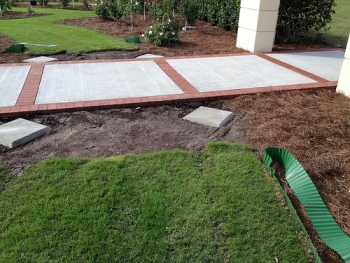JulianConstruction.com: Foundations and Soil Issues

Soil is made up of sand, silt and clay, along with organic materials. Soil types are determined by the mixture of these elements. For example, expansive soil, also called clay soil, has a higher concentration of clay particles than any other type of soil, while sandy soil has more sand particles. Sand particles are also large, while clay particles are extremely small. The clay particles also stick together, which prevents air from passing through the soil and causes any water that accumulates in the soil to drain more slowly.
A foundation built on expansive soil can have foundation problems more easily than those built on other types of soil. This is because when expansive (clay) soil becomes moist, it expands. The expansion lifts the foundation. The lifting can occur in different places, depending on building load (the weight that is carried by the structure) and the amount of moisture present. For example, expansive soil may push up the corners of a structure more than the center.
When the clay dries, the soil shrinks, leaving gaps in the soil.
Soil expansion can cause foundation cracks and put stress on a building’s structure. Soil contraction can also result in cracks, as well as foundation settlement.
Cracks in a foundation will allow more moisture to enter the structure, which can impact its stability. Foundation settlement can prevent doors and windows from closing properly, cause sloping floors and other structural problems.
Homeowners in regions with distinct wet and dry seasons will usually experience more problems with expansive soil compared to places where soil conditions are consistent all year long. However, rain isn’t the only cause of soil expansion. Sprinklers and plumbing leaks can also affect soil moisture content.
Beginning in the 1950s, many homes were built with piers to prevent foundation damage caused by expansive soil. Over time it was discovered that if the piers weren’t placed deep enough, they could also be raised by expanding soil, sometimes to the point where the pier would fall.
Foundation damage from expansive soil can be minimized if the foundation is extended past the area where the soil’s water content fluctuates. Other solutions to the problem include drainage that directs water away from the structure, or making sure the foundation is strong enough to withstand any swelling and contraction. Grading the soil around the foundation can deter the problem as well.
Another soil issue that can lead to foundation damage is improper compaction. This usually occurs when the foundation is built. If the soil beneath and around the foundation wasn’t compacted properly, it can cause uneven settlement.
How do you know if you have soil issues or a foundation problem? Contact a foundation repair expert and ask for a foundation inspection. A foundation contractor will not only know where to look, but what to look for, when conducting the inspection. If there is a situation that needs to be addressed, a foundation repair specialist will be able to recommend the right foundation repair solution for your particular situation. Resolving problems quickly can reduce foundation repair costs and help prevent more severe damage that could require foundation replacement.
